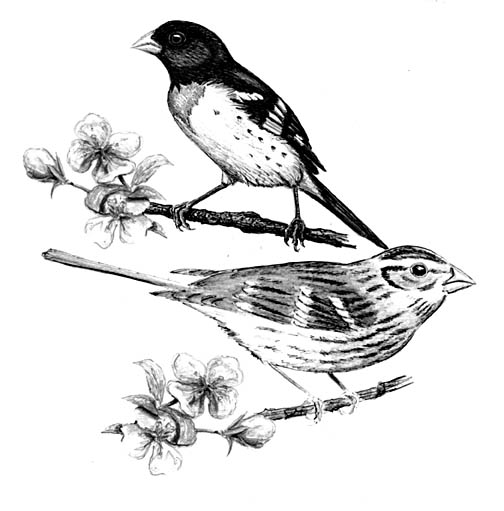
Dear Bird Folks,
A strange bird has been eating sunflower out of our bird feeder. It’s about the size of a cardinal. It has no crest, but it does have a huge cardinal-shaped beak. Except for a line above the eye, the bird is mostly brown, like a sparrow, a really big sparrow. In fact, we have started calling him Jumbo, because he looks like the biggest sparrow we’ve ever seen. Any idea what it is? Is there such a thing as a super-sized sparrow?
– Alan, Truro, MA
Nope, Al,
There are no super-sized sparrows living in Truro. However, I almost had some really big birds living in my yard in Orleans. One dark morning last winter, I went into our unlit shed and poured a bag of seed into my feeder. As I was hanging it up I realized that I had mistakenly filled the feeder with my wife’s plant food. Fortunately, I caught my mistake before the birds got into it. Feeding birds fertilizer would have been bad, but it could have been worse if the squirrels had gotten into it. Can you imagine a town filled with giant squirrels, all pumped up on Miracle-Gro? We’d all have to move into underground bunkers.
Based on your excellent clues, Al, I’m pretty sure that your mystery bird is a Rose-breasted Grosbeak. But you must stop calling him “Jumbo.” Why? Because he is a she. The big brown bird you saw eating at your feeder was a female Rose-breasted Grosbeak. Also, bird or no bird, anytime you refer to any female as Jumbo you are looking for trouble. Believe me, I’ve learned the hard way.
Every spring migration has its own surprises. Some years, people seem to get lots of Indigo Buntings; other years, lots of Scarlet Tanagers are reported. 2008 appears to be the year of the Rose-breasted Grosbeak. We have had dozens and dozens of calls about them. Admittedly, we’ve had very few calls about the large sparrow-looking female. Most calls are about the unmistakable male Rose-breasted Grosbeak. With his handsome black head, white belly, and brilliant red chest, it’s nearly impossible to misidentify this well-marked bird. I said “nearly” because we did have one very upset lady who called to report a bird at her feeder that was “bleeding.” I told her not to worry and sooner or later another bird, a nightingale by the name of Florence, would be by to take care of it. I don’t think she got it.
Most people don’t seem to notice the female grosbeak; her dull coloring makes her less obvious. In addition, she arrives later than the male. By arriving later the cryptic female is often hidden by the fast-growing foliage on the trees. In fact, once the deciduous trees become completely filled out even the males become difficult to find. At this point, the best way to locate a male Rose-breasted Grosbeak is by his signature song. Ornithologists often describe the grosbeak’s beautiful song as sounding like a robin that has taken voice lessons. Don’t ask me how the bird can afford voice lessons. Ornithologists don’t always think these things through.
Like most songbirds the male grosbeak sings to attract a mate and to announce his territory. If another male starts singing within an established territory, the new bird is immediately given the bum’s rush. However, grosbeaks do have their own kind of Good Neighbor Policy. A resident bird is totally cool if a migrating grosbeak stops in its territory to rest and refuel, just as long as it doesn’t sing. Even grosbeaks understand the importance of tourism.
The male Red-breasted Grosbeak is not only handsome and an excellent singer, but he is a good husband, too. The male helps choose the nest site and helps build the nest. However, his nest building skills are more like those of an accountant. The nests are often so flimsy that daylight can be seen shining through the bottom. The male also gives his mate a break by taking his turn sitting on the eggs. In order avoid detection by predators most birds remain silent while incubating, but the male grosbeak has the unusual habit of continuing to sing while he’s sitting on the nest. Apparently, the bird figures he has paid for the voice lessons and wants to get his money’s worth.
The grosbeak’s name comes from the French word, grosbec, meaning “large beak,” making it the favorite bird of Charles de Gaulle. With such a large bill grosbeaks have little trouble opening most seeds, especially sunflower seeds. They also eat their fair share of insects. Many songbirds, after catching large unwieldy bugs, have to repeatedly smash them on a branch before they can be swallowed. This is not a problem for the Red-breasted Grosbeak. A few chops with the powerful bill and down the hatch it goes.
Your super-sized sparrow is migrating, Alan, and probably won’t be around too much longer. Although common in other parts of Massachusetts, Cape Cod doesn’t seem to appeal to most Rose-breasted Grosbeaks. I’m not sure why they don’t like it here, but it could have to do with our lack of broad-leafed forests, which is their preferred habitat. Either that or they’re frightened away by the rumors of giant Miracle-Gro-filled squirrels roaming the streets of Orleans. I think we’d all be frightened by those rumors.